road
Latest

Researchers tap AI for more efficient road maintenance
Potholes are a nuisance pretty much everywhere and the methods traditionally used to keep track of them aren't terribly efficient. Whether it be driving around to visually inspect roads or watching videos of streets to spot and prioritize the repair of pavement damage, strategies typically used by towns and cities require a fair amount of time and labor. But AI could make that process a bit easier and quite a bit faster. One group exploring the use of AI to support the municipal officials in charge of road maintenance has been developing a software system that could not only aid in road repairs but also bridge and building maintenance as well.

UK plans to let drivers report road accidents online
British road users may soon be able to report accidents online, under new plans drawn up by the Department for Transport. The consultation, opened today by Transport Minister Jesse Norman, will allow citizens to suggest new ways for drivers to share details of traffic incidents with police and save time in the process.
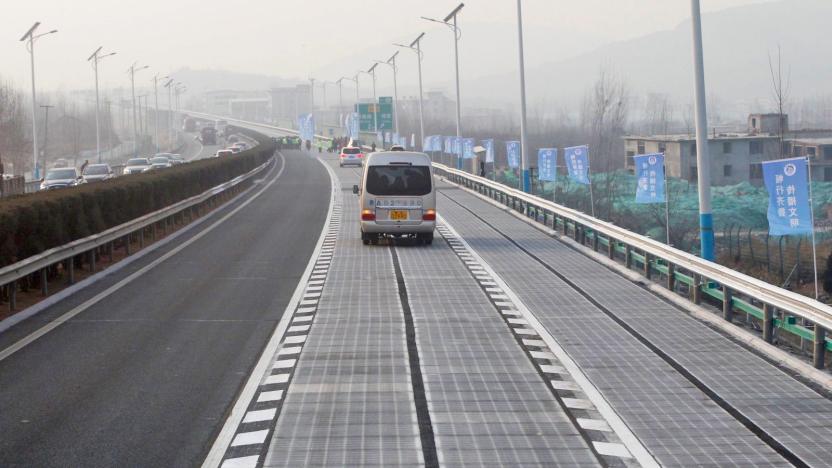
Thieves swipe a portion of China's solar road
Solar roads have plenty of potential problems, such as damage and snow, but theft? Apparently that's a concern, too. China's Qilu Evening News reported that thieves carved out a small (5.9in by 73in) portion of an experimental road in Jinan on January 2nd, a mere five days after its December 28th debut. While it's tempting to suggest this was an accident, officials said the missing segment was "neatly cut," and didn't appear to have come loose on its own.

BMW hopes AI-managed electric bike roads will ease traffic
In some cities, the most common electric vehicles are likely to be two-wheelers like bikes and motorcycles. But cities aren't really designed for them -- you have to compete with cars on the road and at charging stations. BMW and Tongji University think they can do better: they've developed a concept, Vision E3 Way, that gives e-bike riders their own roads. The paths would be safer and reduce traffic congestion, as you might expect, but they'd also take advantage of the electric nature of the vehicles to make two-wheel riding more accessible.
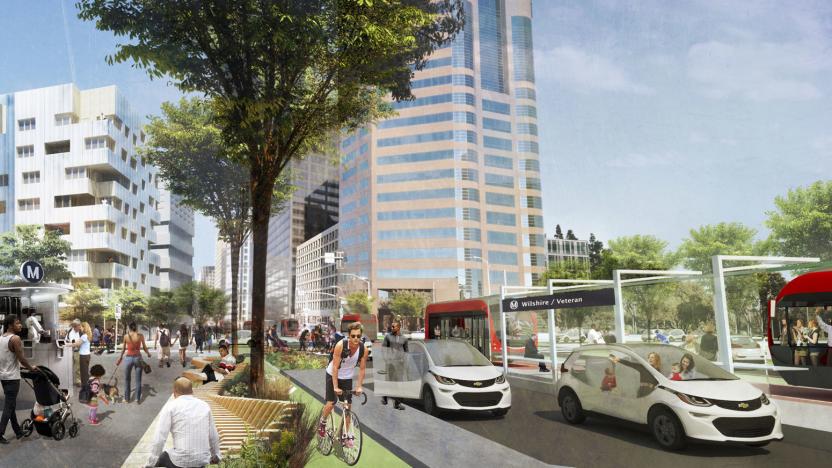
Lyft thinks it can fix Los Angeles traffic with fewer lanes
For the past several decades, cities have designed streets around the assumption that they'll be used for personal cars. If you need a poster child for this, you just have to look at Los Angeles' Wilshire Boulevard -- it has a whopping 10 lanes for vehicles, and even the bus lanes are almost treated like afterthoughts. It's no wonder gridlock is such a common problem, since LA is practically inviting more drivers and the traffic chaos that results. Lyft isn't happy with this state of affairs, and it thinks urban planners need to reinvent the road if they want to reduce traffic and embrace the future. It's partnering with designers at Perkins+Will and Nelson/Nygaard on a conceptual Wilshire Boulevard redesign for an era when car ownership fades away and public options dominate. There would be fewer lanes, but it could potentially serve up to 77,000 people per hour instead of today's 29,600.
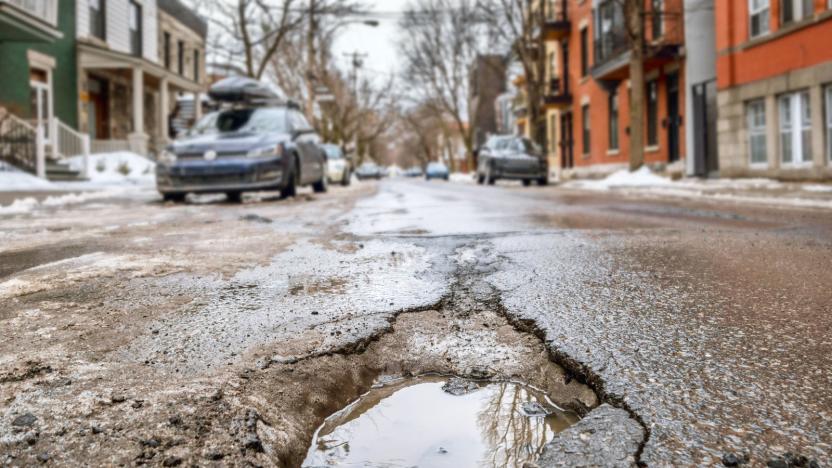
Self-repairing roads could also charge your electric car
Potholes are bad enough for the jarring rides, car damage and safety hazards they create, but it's also problematic to fix them. You're looking at lane and road closures that can last for days, assuming the city can even spare the resources. However, Dutch researchers might have a solution that not only helps the road fix itself, but promises to solve range anxiety for electric car drivers. Delft University's Erik Schlangen tells The Verge that there are plans to test self-repairing asphalt whose conductive steel fibers and bacteria would both fix small cracks in the pavement and send electricity to EVs above. The trial will charge your vehicles when you're stopped at intersections, giving you a little bit of extra range in those moments you're waiting for the light to turn green.
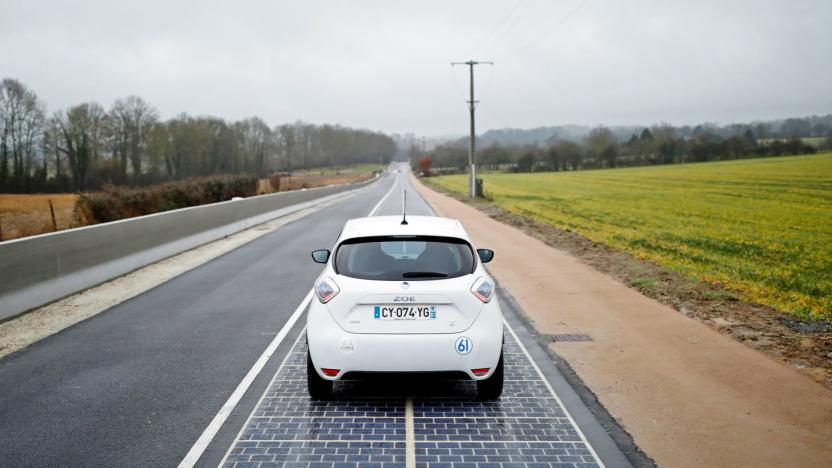
A French town just installed the world's first 'solar road'
The tiny town of Tourouvre-au-Perche in Normandy, France no longer has to worry about how it will power its street lights. The Sun will handle that.
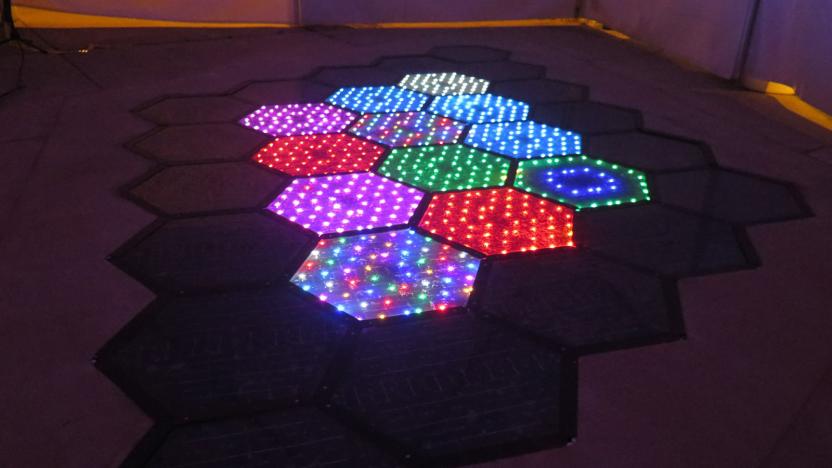
Solar road tiles get their first public test
No, that's not an elaborate new Lite-Brite kit-- that's the possible future of energy. After years of work (and some last-minute delays), Solar Roadways has installed its first public energy tiles in Sandpoint, Idaho as part of a test. On top of producing a light show, the panels will generate power for the fountain and restrooms in a public square. They have heating elements, too, so they should keep running even in the heart of winter. And if you're not sure how well they'll work in practice, you can check on them yourself -- Sandpoint has a live webcam pointed at the tiles.

Plastic roads may put asphalt to shame
The days of putting up with crumbling asphalt streets might just come to an end. Construction company VolkerWessels has revealed plans for recycled plastic roads that are both more sustainable and more practical than old-fashioned blacktop. Besides reusing material, they'd last about three times longer and survive greater temperature ranges (between -40F and 176F) -- despite their fragile look, they're less likely to crack under the strain of vehicles or the weather. You can pre-assemble them to lay them down faster, too, and their hollow structure is handy for cabling and pipes.

Future Range Rovers could tell the city about local potholes
Jaguar Land Rover has revealed that it's working on technology that'll alert the authorities whenever your car finds a bump in the road. It's one of several high-tech initiatives the outfit has been working on, including heads-up displays in the windshield and "transparent" cars. Once an issue, like a pothole or broken drain, has been discovered, its location will be uploaded to the authorities who can then send a maintenance crew to come fix it. In the meantime, the information can be shared with nearby vehicles so that motorists in the vicinity can avoid damaging their car.

London tests traffic lights that stay green for cyclists
Cycling is one of the quickest ways to get across London, and soon adaptive traffic lights could make pedal-power even faster. Transport for London (TfL) is testing a system that detects groups of cyclists and, where possible, keeps the lights green for a little longer than usual. The problem being that during peak times -- for instance, the morning commute -- tons of cyclists take to the streets, causing congestion at major junctions.

The first solar bike path is producing more energy than expected
Back in November, SolaRoad launched a test bike path that generates energy through solar cells embedded in the concrete. It sounds like an outlandish idea, but it's apparently paying off very quickly. The company has revealed that its road has generated much more energy than expected -- it produced 3,000kWh of electricity in the space of just six months, or enough to power a single person's home for a year. That doesn't sound like much, but SolaRoad notes that its path only covers a 230-foot stretch in a Dutch village. You'd get a lot more energy from longer, wider roads.

Scientists investigating AI-based traffic control, so we can only blame the jams on ourselves
Ever found yourself stuck at the lights convinced that whatever is controlling these things is just trying to test your patience, and that you could do a better job? Well, turns out you might -- at least partly -- be right. Researchers at the University of Southampton have just revealed that they are investigating the use of artificial intelligence-based traffic lights, with the hope that it could be used in next-generation road signals. The research uses video games and simulations to assess different traffic control systems, and apparently us humans do a pretty good job. The team at Southampton hope that they will be to emulate this human-like approach with new "machine learning" software. With cars already being tested out with WiFi, mobile connectivity and GPS on board for accident prevention, a system such as this could certainly have a lot of data to tap into. There's no indication as to when we might see a real world trial, but at least we're reminded, for once, that as a race we're not quite able to be replaced by robotic overlords entirely.

New EU legislation requires cars to include autonomous braking system
While we're still a long way from living the fully autonomous car dream, baby steps are being taken. The EU evidently shares this dream, and has passed regulations that will require new cars to have emergency self-braking systems (known as autonomous emergency braking, or AEB) if they want to achieve a five-star safety rating. The systems can use radar, laser or video to detect when obstructions or pedestrians are present, and a recent study suggests that the technology reduces accidents by up to 27 percent. Commercial vehicles will have to sport the systems from November next year, and everything else from 2014. Safety aside, we're thinking that anything that can help prevent rear-ending our new ride, is definitely a welcome addition.

Japanese group transmits electricity through 4-inch concrete block, could power cars on roads
The decision to invest in an electric vehicle would be much easier to justify if the car in question offered unlimited range. That appears to be the concept behind a Toyohashi University research group's wireless power prototype, which can successfully transmit electricity through a 10 centimeter-thick concrete block. During a demonstration in Yokohama, Japan, the team sent between 50 and 60 watts of power through a pair of concrete blocks to two tires, which then juiced up a light bulb (you can see the rig just above). The project is called EVER (Electric Vehicle on Electrified Roadway), and could someday be used to keep cars moving along a highway without any need to pull over for a recharge, thanks to a constant stream of electricity coming from below the road. There are some serious obstacles to overcome before EVER can get some wheels turning -- namely, a need to pump nearly 100 times the current maximum load through concrete that's twice as thick as what they've managed today, not to mention improving undisclosed efficiency levels -- but the group reportedly said that it's up to the task, making us fairly optimistic that such a solution could one day get us from A to B without petrol. Until then, you'll probably want to plan out a pit stop or two before you leave the garage.

Five apps (and more) for the summer road trip
The Independence Day holiday week is upon us, and millions of American families are heading out on the open road. Where past generations depended on paper maps and Mad Libs, the march of technology has given us new tools for kids and parents alike. Our five-plus apps for road trips are accompanied with standbys and alternates to match up with your specific travel needs. Got other favorites or recommendations? Give them a shout out in the comments. When I was young, in the pre-cellphone days, our road trips with other families included walkie-talkies or CB radios to help coordinate bathroom stops or route changes. Even with iMessage and hands-free headsets, there's something to be said for the one-button convenience of push-to-talk -- just ask the crowd of satisfied and loyal Nextel users who depend on the technology every day. Three popular apps that simulate the PTT experience on the iPhone are Voxer, HeyTell and Zello (all free). All the walkie-talkie apps offer one-to-one or group voice chat at the press of a virtual button. Voxer's got Facebook integration and a rapidly growing userbase, plus photo and text sharing (and some hefty funding); Zello's got a simple UI including "one big button" for PTT conversations with the other cars in your convoy; and HeyTell's got geographic indicators for your chat partners plus in-app purchases for fun items like voice changers. Any one may save you some dialing and phone calling while you're looking for your next pitstop, so consult with your fellow vacationers and settle on the one you like. Eyes on the road, please! If you want to automatically alert your friends or family at your destination that you're making progress, check out the free En Route! or the $0.99 just-released iETA. Both apps will automatically update your selected contacts with your expected arrival time and optionally share your location as you go. Other options in this vein: Glympse, Google Latitude or Apple's Find my Friends app. Want to make sure you've got solid 3G or LTE coverage where you're headed? Reader Chris suggests his $2.99 Coverage! app, which consolidates multiple carrier maps into one convenient view. Getting there is half the fun, and getting distracted along the way is at least 15% of the fun. Roadside America for iPhone ($2.99 + IAP) delivers a mapped guide to the silly and serious attractions that make a road trip memorable. Buying the app unlocks a single region of the US & Canada, with a $1.99 option in-app to purchase additional regions or $5.99 to unlock them all permanently. You can track your attraction visits, upload photos, get sunset alerts to time your visits to scenic sites, and of course get directions/hours and phone numbers. Not to be confused with the one and only Roadside America miniature village in Shartlesville, PA, which is absolutely mandatory if you're taking I-78 through southeastern Pennsylvania. Speaking of I-78, I'm positive that my wife and I have made the same mistake at least four times on that highway -- taking an exit for lunch at Friendly's only to find that it's a five-mile winding drive to get to the restaurant, when there's one right off the highway two exits further on. The solution may be iExit for iPhone and iPad (now on sale for $0.99, usually $1.99), which gives you a list of all the amenities and dining options for up to 100 exits on down the road. You can sort your iExit results by type (hotels, gas, fast/slow food, coffee) or identify favorite outlets for more filtering choices. iExit also comes in $0.99 Food and Hotel versions (not much point in buying them while the main app is on sale, though) plus a free Lite version; the Lite version only shows what's coming up at the next exit. There's a similar free app called RoadAhead that Mel reviewed last year; on my next highway drive I'll compare it to the Lite version of iExit and see which one stacks up better. Hat tip to CNN for Roadside America and iExit. Of course, the king of the American road guide castle is the venerable AAA Triptik. Readers of a certain vintage may remember the paper strip maps from AAA with manually highlighted routes, mileage indicators and approved motels & restaurants marked along the way. Triple-A has also changed with the times, as seen in the AAA Triptik Mobile app (free). Integrating maps and navigation details from NAVTEQ, the app simulates the experience of the old paper Triptiks by letting you shake your iPhone (or press an onscreen button) to announce the next navigational maneuver; not exactly turn-by-turn, but not bad. It also lists AAA-approved hotels, restaurants, campgrounds and more. You can also get navigational help and geosearch from the built-in Maps app, naturally, and from apps such as Mapquest (free) and MotionX GPS Drive ($0.99 plus subscriptions). AAA's separate, free Roadside app is also a must-have for members, as it ties into the complimentary roadside service and towing options from the association. If you'd rather document your journey with a photo journal, there are apps for that too. The latest entry is the free Rough Guides Trip Lens, incorporating technology from the HipGeo trip journal app. Trip Lens gives you an Indiana Jones-style map path with your photos along it, even if you took them far away from WiFi or cell towers -- the geocoded photos are cached and uploaded when you're back in range. You can share or send photos, see other shots taken nearby, and give family or friends a custom URL where they can follow along with your travels. Keeping pointed in the right direction is one thing; keeping everyone from boredom-induced road coma is another thing entirely. BoingBoing points out the social trivia app Trivi.al, available in ad-supported or paid ($2.99) versions. Compete against other quizmasters around the country to see who's got the fastest finger and the sharpest recall... and watch the miles fly by. Being on the road means being away from your familiar -- and presumably secure -- home and work WiFi networks. To keep your mobile connections protected on Random Truck Stop Network, a VPN is a good idea. The commercial VPN service Hotspot Shield secures your data with a bonus; compression routines squeeze your data requirements down so that if you're stuck using your 3G or 4G connection, you can minimize the amount of your quota that gets chewed up. Hotspot Shield subscriptions for a single iOS device run $0.99 a month or $9.99 per year, but there is a current deal via Parallels that gets you protection for up to five computers and five iOS devices for a year for $39.95. Finally, when you do step away from the car for a few minutes of sunbathing, you'd better know how much UV you're absorbing before you burn (sticking to the car seat = an uncomfortable ride). Katie Couric's blog, of all places, points to the UV Safe Timer app (free). This tool takes the actual weather at your location into account when computing your sun exposure, along with your activities and skin type. A timer alerts you when you're due for a reapplication of sunscreen. And wear a hat! Photo by C.G.P. Grey | flickr cc

Predictably named iPavement puts hotspots into the sidewalk
We know what it's like to be in a foreign country without a mobile internet connection. Although there are domestic options making it easier to connect our devices abroad, Spanish company iPavement wants to help confused tourists (and their confused devices) by seamlessly integrating hotspots into tiles -- which are seamlessly integrated into the ground. It's unclear whether users will have open access to the entire world wide web, or only controlled info about the city, but the service is at least free to use. The 24kg (53lb) tiles are slightly larger than normal, installed a maximum of 20 meters (66 feet) from one another and only work at temperatures between -10 - 45 degrees Celsius (14 - 113 degrees Fahrenheit). Touristy cloud apps like maps, coupons, and traffic updates in various languages are also a part of the deal, and you would look like less of a tourist without that huge guide to Madrid. Just lose the fanny pack and you'll be set.

Cordon multi-target photo-radar system leaves no car untagged (video)
Go easy on the gas, Speed Racer, because Cordon is on its way. Developed by Simicon, this new speed sensor promises to take highway surveillance to new heights of precision. Unlike most photo radar systems, which track only one violator at a time, Simicon's device can simultaneously identify and follow up to 32 vehicles across four lanes. Whenever a car enters its range, the Cordon will automatically generate two images: one from wide-angle view and one closeup shot of the vehicle's license plate. It's also capable of instantly measuring a car's speed and mapping its position, and can easily be synced with other databases via WiFi, 3G or WiMAX. Plus, this device is compact and durable enough to be mounted upon a tripod or atop a road sign, making it even harder for drivers to spot. Fortunately, though, you still have time to change your dragster ways, as distributor Peak Gain Systems won't be bringing the Cordon to North America until the first quarter of 2012. Cruise past the break to see some footage of a field trial that's currently underway -- cars tagged with a green dot are traveling below the speed limit, those with a yellow marking are chugging along within an acceptable range above the limit, while vehicles with a red tab are just asking for trouble.

Proposal would put a solar garden on the Brooklyn-Queens Expressway
If you've ever spent any time on New York City's finest roadway, the Brooklyn Queens Expressway, garden is not one of the first words that comes to mind. That could change on one particular strip in Brooklyn if a concept -- which you see above -- gets approved and built. The concept is part of a project calling for solutions to a trench that runs from Carroll Gardens to the Columbia Street Waterfront in Brooklyn. Starr Whitehouse Landscape architects floated three possible solutions for improving the stretch, which would cost between about $10 and $18 million, very cheap in comparison to other projects of this type. The Green Canopy proposal calls for a massive plant covered canopy with solar panels to stretch over top of the entire area making it self-sustaining and reducing noise in the area. Hit up the source to check out the other proposed projects.

GM shows off sensor-laden windshield, new heads-up display prototype
Heads-up displays are undoubtedly novel, and downright useful in the right circumstances. Trouble is, few of these prototypes ever make it beyond the lab, and we're stuck using these same two eyeballs to experience the world around us. General Motors is evidently tired of the almosts, and it's now working in concert with Carnegie Mellon University and the University of Southern California in order to concoct one of the most advanced HUD systems that we've seen -- particularly in the automotive world. Setting out to create "enhanced vision systems," GM's R&D team has created a windshield packed with visible and Infrared cameras along with internal optics that keep a close eye on the driver's retinas. In the images and video below (hit the 'Read More' link for the real action), you'll see a solution that utilizes lasers in order to highlight road edges, speed limit signs and all sorts of other vital bits of data during a fog-filled commute. Best of all? We're told that some of these technologies "could end up in GM vehicles in the near-term future." Granted, the Volt was supposed to set sail already, but we suppose we'll give 'em the benefit of the doubt. %Gallery-88465%











